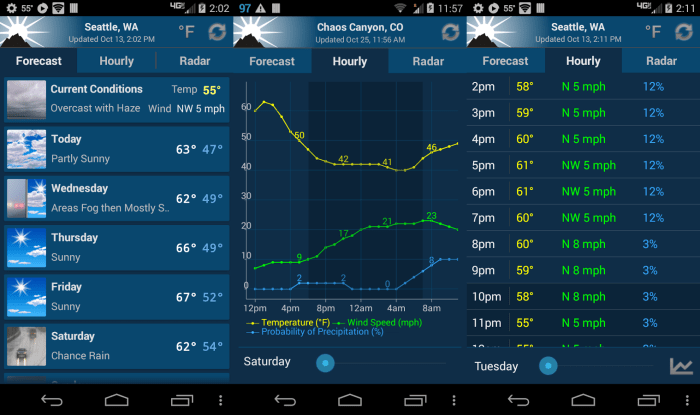Best Weather Apps for Android
Weather apps have become indispensable tools for staying informed about the conditions around us. From quick glances at the forecast to detailed hourly predictions, these apps cater to a wide range of needs. Choosing the right app depends on individual preferences and specific use cases.
Introduction to Weather Apps
Android weather apps provide a plethora of information about current and future weather conditions. A user-friendly interface is crucial for a positive user experience, allowing users to easily access and interpret data. Key features that distinguish excellent weather apps include accurate predictions, reliable data sources, intuitive navigation, and visually appealing displays. Weather apps can be categorized into simple, advanced, and specialized apps, each with its own set of features and target users.
- Simple Apps: These apps provide basic information like temperature, conditions, and the forecast for the next few days. They prioritize ease of use and are often suitable for casual users.
- Advanced Apps: These apps offer detailed information, including hourly forecasts, radar maps, and specific data for different locations. They cater to users seeking more in-depth weather insights.
- Specialized Apps: These apps are tailored to specific needs, such as severe weather alerts or detailed agricultural forecasts. They often focus on niche applications of weather information.
| App Name | Key Features | User Rating (Example) |
|---|---|---|
| AccuWeather | Detailed forecasts, radar maps, alerts | 4.5 stars |
| WeatherBug | Real-time updates, severe weather alerts, radar | 4.3 stars |
| The Weather Channel | Comprehensive forecasts, interactive maps, severe weather warnings | 4.4 stars |
Features Comparison
Evaluating weather apps involves comparing various features like accuracy, reliability, and the presentation of weather data. Accuracy can be assessed by comparing the app’s predictions with actual weather conditions over time. Different display formats cater to diverse user preferences, ranging from simple text displays to interactive maps and graphs.
| App | Accuracy (Example) | User Rating (Example) |
|---|---|---|
| AccuWeather | High accuracy in general predictions | 4.5 stars |
| WeatherBug | High accuracy for severe weather warnings | 4.3 stars |
| The Weather Channel | Accurate overall, with occasional discrepancies | 4.4 stars |
| Format | Description | Advantages | Disadvantages |
|---|---|---|---|
| Text-based | Simple display of key data | Easy to read, lightweight | Limited information, less engaging |
| Graphical | Includes charts, graphs, and icons | Visually appealing, shows trends | Can be complex for some users |
| Map-based | Shows weather data on a map | Visualizes regional variations, easy to locate | Can be cluttered, may require internet access |
User Experience
A smooth and intuitive interface significantly enhances the user experience. Users appreciate clear navigation, simple menus, and easily accessible information. Common user complaints often involve slow loading times, inaccurate predictions, or confusing interfaces. Apps like AccuWeather and WeatherBug often receive praise for their intuitive design and responsiveness.
Data Sources and Accuracy
Weather data in apps is collected from various sources, including weather satellites, radar systems, and surface observations. The reliability of these sources varies, influencing the accuracy of the app’s predictions. Factors like location data and the algorithm used by the app also impact accuracy.
| Data Source | Description | Accuracy |
|---|---|---|
| Satellite Data | Provides large-scale overview of weather patterns | High |
| Radar Data | Provides real-time information about precipitation | High |
| Surface Observations | Provides localized weather information | Medium to High |
Closing Notes

Choosing the best weather app for Android hinges on individual preferences and specific needs. This comprehensive guide has explored the diverse landscape of weather applications, providing insights into essential features, user experience, and data accuracy. By considering factors like data sources, visual representation, and app performance, users can make an informed decision aligned with their needs. Ultimately, the “best” app is the one that delivers accurate, reliable, and user-friendly weather information tailored to your specific requirements.



